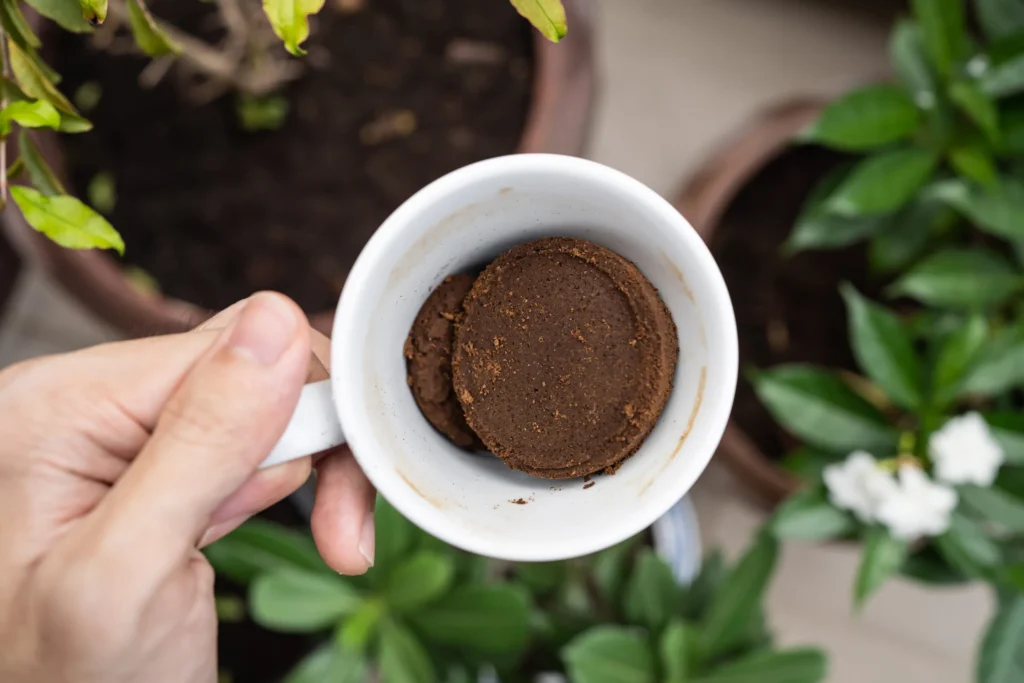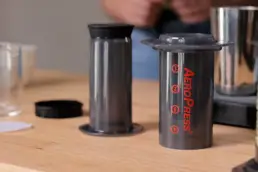Table of Contents
ToggleIntroduction:
If you are like me, then you’ve probably wondered what to do with your used coffee grounds.
The first time I used my Moka pot to brew coffee at home, I could not discard the used coffee grounds. I instinctively knew it could be useful in other ways. Ways I wasn’t clear on at the time. I just kept storing the used coffee grounds knowing that one that. they will be useful in other ways.
In our quest for sustainability, we often overlook the potential of everyday items. Instead of tossing your used coffee grounds, you can find other ways that they are useful to you.
In this post, we’ll look at five innovative and eco-friendly ways to repurpose your used coffee grounds, transforming what was once considered waste into a valuable asset for your home, garden, and beauty routine.

5 Ways To Transform Used Coffee Grounds Into Household Treasures
Supercharge Your Garden
Coffee grounds are a gardener’s secret weapon. Rich in nitrogen, they can work wonders for your soil and plants. Here’s how you can put them to use:
Compost Booster: Add coffee grounds to your compost pile. They’re considered a “green” material, high in nitrogen, which helps balance the carbon-rich “brown” materials like dried leaves. The grounds also help attract earthworms, which are great for your compost and soil.
Direct Soil Amendment: Work coffee grounds directly into the soil around your plants. They improve soil structure, promoting better water retention and aeration. This is particularly beneficial for clay soils that tend to be compacted.
Acid-Loving Plant Food: Plants that thrive in acidic soil, love coffee grounds. Sprinkle a thin layer around these plants, but avoid piling them directly against the stem or trunk.
Natural Pest Deterrent: Some gardeners swear by coffee grounds as a natural way to repel slugs, snails, and even cats. Create a barrier around vulnerable plants to keep these pests at bay.
Worm Food: If you’re into vermicomposting, your worms will love coffee grounds. Add them in moderation to your worm bin for happy, well-fed worms.
Remember, while coffee grounds are generally beneficial, use them in moderation. Too much can make the soil too acidic for some plants.
Natural Deodorizer
Coffee’s ability to absorb and neutralize odours makes it an excellent natural deodorizer. Here are some ways to put this property to use:
Refrigerator Freshener: Place a bowl of dried coffee grounds in your fridge or freezer to absorb and neutralize food odours. Change it out every month or so for the best results.
Hand Deodorizer: After chopping garlic or onions, rub your hands with used coffee grounds to remove the strong smell. The abrasive texture also helps exfoliate your skin.
Trash Can Odor Control: Sprinkle dried grounds at the bottom of your trash can to help control unpleasant odours.
Shoe Deodorizer: Fill old socks or stockings with dried coffee grounds and place them in smelly shoes overnight. The grounds will absorb the odour, leaving your shoes fresher.
Room Freshener: For a natural air freshener, place bowls of coffee grounds around your home. They’re particularly effective in small spaces like closets or bathrooms.

DIY Beauty Scrub
Coffee grounds aren’t just good for your garden; they can be great for your skin too. Here’s how to turn them into a body scrub:
Ingredients:
- 1/2 cup used coffee grounds (dried)
- 1/2 cup coconut oil (or olive oil for a lighter scrub)
- 1/4 cup sugar (optional, for extra exfoliation)
- 1 teaspoon of vanilla extract (optional, for fragrance)
Instructions:
- Mix all ingredients in a bowl until properly mixed.
- Store in an airtight container.
- To use, apply the scrub to damp skin in circular motions, then rinse off.
The grounds act as a gentle exfoliant, sloughing off dead skin cells. The caffeine in coffee may also help improve blood flow to the skin, potentially reducing the appearance of cellulite and giving your skin a temporary tightening effect.
Always patch-test new skincare products and use them gently to avoid irritation. This scrub is best used on the body rather than the face, as it may be too harsh for facial skin.
Clean Stubborn Grime
The slightly abrasive texture of coffee grounds makes them an excellent natural cleaner for tough jobs:
Pots and Pans: For stubborn, baked-on food residue, sprinkle coffee grounds on the surface and scrub with a sponge. The abrasive texture helps lift the grime without scratching.
Grill Cleaner: After your BBQ has cooled, sprinkle coffee grounds on a damp cloth and use it to scrub away grease and food particles from the grates.
Fireplace Cleaner: Before sweeping out your fireplace, sprinkle damp coffee grounds over the ashes. This helps weigh them down, reducing the amount of dust that becomes airborne during cleaning.
Scour Tough Stains: For stained cutting boards or countertops, make a paste of coffee grounds and water. Scrub the stain, let sit for a few minutes, then rinse clean.
Remember, while coffee grounds are great for cleaning, they can stain light-coloured surfaces. Always test on an inconspicuous area first and avoid using them on porous materials.
Natural Dye
Coffee grounds can create beautiful, earthy tones on fabric and paper. Here’s how to use them as a natural dye:
Fabric Dyeing:
-
Simmer used coffee grounds in water for about 30 minutes.
-
Strain the liquid and return it to the pot.
-
Add pre-washed fabric (natural fibres work best) to the dye bath.
-
Simmer for an hour, stirring occasionally.
-
Rinse the fabric in cold water until the water runs clear.
-
Hang to dry.
The intensity of the colour will depend on the strength of your coffee solution and how long you let the items soak. Experiment with different concentrations and soaking times to achieve your desired shade.
Conclusion:
From enhancing your garden to creating natural beauty products, used coffee grounds have a multitude of uses beyond the cup. By repurposing this common kitchen waste, you’re not only being eco-friendly but also unlocking a versatile resource right in your home. These five uses just scratch the surface of what’s possible with used coffee grounds.
See more ways to repurpose used coffee grounds here.
Next time you brew a pot, think twice before discarding those grounds – they might just be the solution you’ve been looking for in your garden, cleaning routine, or DIY projects. By finding new life for our used coffee grounds, we take one more step towards a more sustainable lifestyle, turning what was once waste into a valuable resource. So go ahead, save those grounds, and start exploring their potential beyond the brew!
Happy Brewing!
You can buy fresh coffee beans at the Zuma Coffee store.

esewalter
Mom | Yoga Teacher | Coffee Blogger | Legal Mind. I explore coffee's journey from farm to cup and especially how you can start your home brewing journey.



